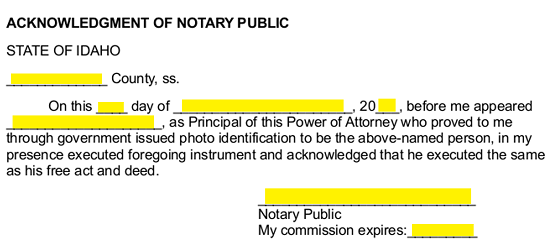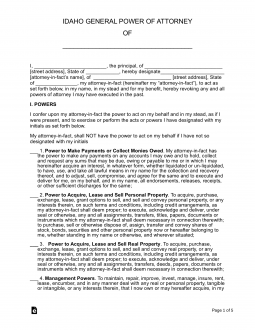Updated August 08, 2023
An Idaho general (financial) power of attorney designates the authority an agent requires to represent a principal’s interests in pre-defined areas of that principal’s finances. It is generally considered wise to make sure that all the information that is presented through this paperwork is a true and accurate representation of the principal’s decision to delegate their authority to the concerned agent. This can be as broad or as specific as the principal believes appropriate, but it is suggested that a clear line of communication be available between the principal and the agent while this document is in effect. Unlike a durable POA, this form can be established so it will become null and void if the person granting the authority (or principal) is declared incapacitated.
Laws
- Statutes – Chapter 12 — Uniform Power of Attorney Act
- Authority (I.C. § 15-12-201) – An agent under a power of attorney may act on behalf of the principal and exercise broad authority as granted by the agreement.
- Signing Requirements (I.C. § 15-12-105) – Notary Public.
How to Write
Download: PDF, MS Word, OpenDocument
1 – Principal Declaration
The Principal or Grantor of Power must be identified twice at the beginning of this document.
First, enter the Name of the Principal on the blank line beneath the Title of this form.
Record the Grantor’s Name, Street Address, and State using the first three blank spaces in the first statement of the first paragraph.
Next, make sure to declare the Full Name, Street Address, and State of the Grantee accepting this responsibility and authority on the next three blank lines.
2 – Provide A Detailed Report On The Grantee’s Assumed Principal Power
The Grantor should initial each Statement of Authority that contains definitions of Power that should be appointed to the Grantee. There will be sixteen subjects for the Principal to review then, an area where he or she provides detailed directives to the Grantee and any relevant party.
The first statement of authority, “Power to Make Payments or Collect Monies Owed,” may be delegated to the Grantee, once the Grantor initials the space preceding the number “1.”
The second item, “Power to Acquire, Lease and Sell Personal Property,” provides Principal Authority to the Grantee regarding the Grantor’s Personal Property.
The third statement of Authority will deliver Principal Power over the Grantor’s Real Property, once the Grantor supplies his or her initials on the available blank line.
The fourth statement of authority will grant Principal “Management Powers” to the Grantee if the Grantor initials the “Management Powers” statement.
The “Banking Powers” in the Principal’s control may be delegated to the Grantee, once the Principal initials the fifth statement.
The Principal Authority regarding Motor Vehicles will be assigned through the Grantor’s initials on the sixth statement of Authority.
The Grantor can give the Attorney-in-Fact authority regarding the Principal’s Taxes by initialing the seventh statement.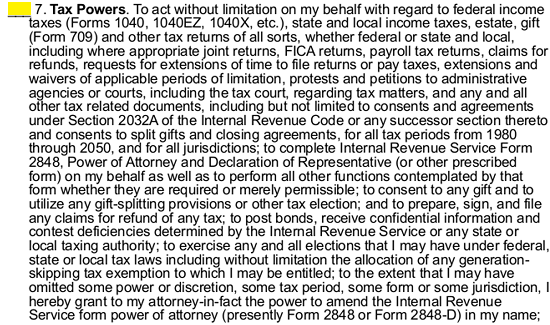
The eighth subject will provide wording for the Grantor to give the Grantee access and power regarding his or her Safe-Deposit Boxes, once it is initialed by the Principal.
If the Grantee may act as a Principal Agent with Gift Making Powers, the Grantor will need to initial the ninth subject of power.
The tenth statement of Authority provides the Grantee with Principal Powers regarding the Grantor’s “Lending and Borrowing” practices, once it is initialed by the Grantor. ![]()
If the Grantor wishes to designate the Attorney-in-Fact with Principal Power relating to his or her “Contracts,” the eleventh paragraph should be initialed by the Principal.![]()
The Principal may grant “Health Care” powers to the Agent by initialing the twelfth paragraph.
The Grantor will empower the Grantee with the power and authority regarding Health Care Matters under the Health Insurance Portability and Accountability Act of 1996 by initialing the thirteenth statement.![]()
The recipient of this delegation of Authority will have the “Power to Hire and Pay for Services” in the Grantor’s Name once, the Principal initials the fourteenth power.
The “Reimbursement of Attorney-in-Fact” statement will allow the Grantee to recoup expenses in relation to his or her Principal duties, once the Principal initials the fifteenth statement.![]()
The Grantee will have the “Power to Sue Third Parties Who Fail to Act Pursuant to Power of Attorney,” on behalf of the Principal, once the Grantor initials the sixteenth paragraph.
The seventeenth statement will enable a Principal to deliver direct instructions that have not been previously mentioned. If the Principal wishes to place any conditions, restrictions, or limitation on the powers delivered or wishes to grant extensions of powers, he or she will need to initial the blank line.
3 – The Term Period Of Effective Power
The Grantor may determine and declare exactly when the Grantee’s Principal Power should be respected as valid. Section III, “Effective Date and Termination,” will give the Grantor a clearly defined area to present such wishes.
The Grantor may choose this document to go into effect immediately upon signing by initialing the blank line just before the words “Upon the date…”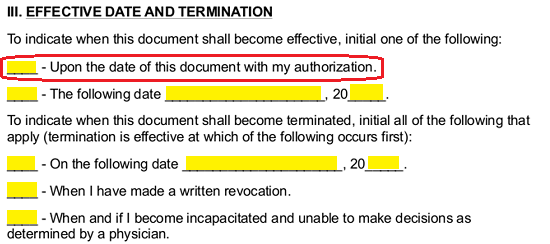
The second option will allow the Principal to choose an exact Date of Effect. If this is preferable the Principal must initial the second choice and enter the Start Date of this form’s effect.
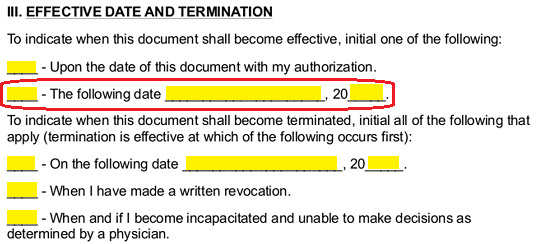
The next task will be to set the Termination Date of these powers. This can be conveyed using the choices below the statement “To indicate when…”If the appointments in Principal Authority granted to the Attorney-in-Fact should automatically terminate on a specific date, the Principal should initial the first choice then supply this Termination Date using the spaces provided.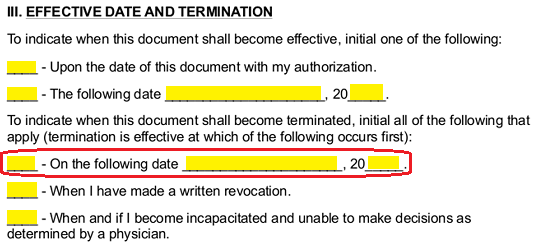
If this document’s appointments of authority only terminate upon the Grantor’s Revocation, this Principal will need to initial the second statement (“When I have…”).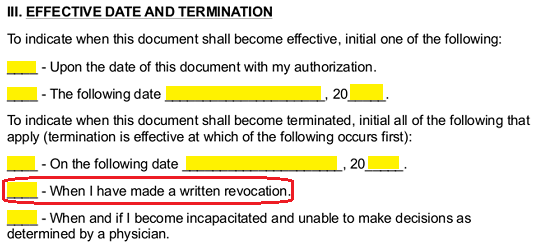
The powers appointed through this document’s execution may remain intact until the Principal is rendered incapacitated or unable to make decisions when the Principal initials the third choice.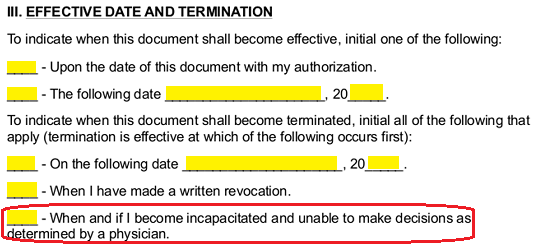
4 – Approved Third Party Instruction
Section IV must be directly approved through the Grantor’s Signature. Such a signature must be dated.
The Grantor must enter the Date of Signature in the last statement of this form.
This form will be completed once the granting Principal Signs and Prints his or her Name on the two blank lines.
5 – The Grantee’s Acceptance of Agent Responsibility
The Attorney-in-Fact’s Full Name should be entered on the first blank line in the “Acceptance of Appointment” statement. Below this, the Attorney-in-Fact should sign and print his or her name in the spaces provided to signify acknowledgment of this document.
There will also be a Witness Statement. Two individuals should view the Principal and Attorney-in-Fact signing of this form. Each one should read the Witness Statement provided then Sign his or her Name. Next, to the Signature, the Signature Witness must supply his or her Address.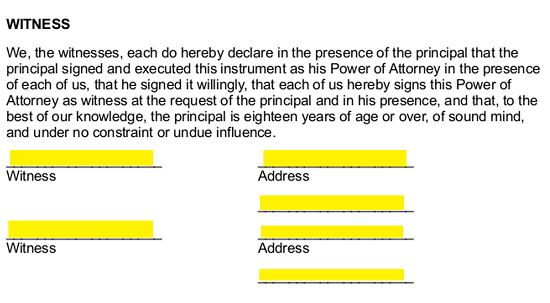
Once all these Signature Tasks have been completed the Notary Public who has observed these actions will notarize this document in the “Acknowledgment of Notary Public” section.